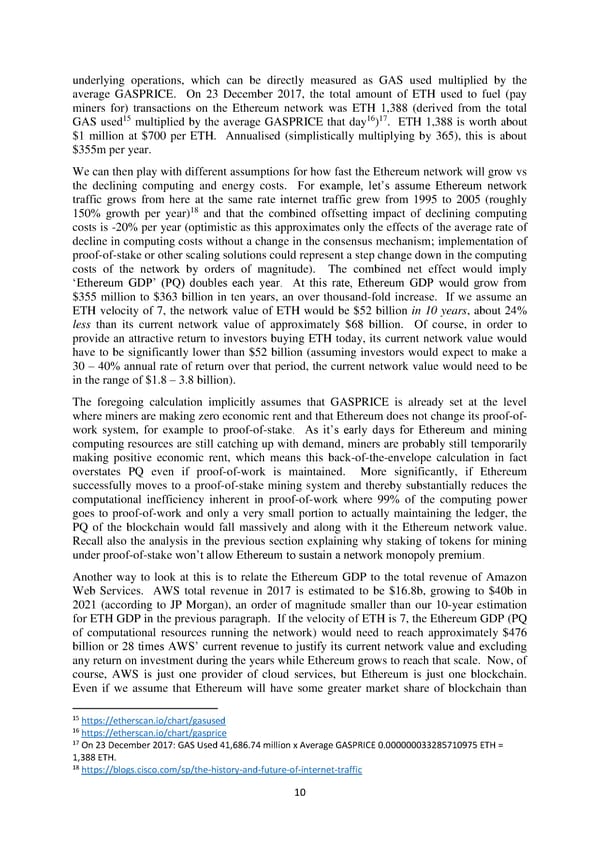underlying operations, which can be directly measured as GAS used multiplied by the average GASPRICE. On 23 December 2017, the total amount of ETH used to fuel (pay miners for) transactions on the Ethereum network was ETH 1,388 (derived from the total 15 16 17 GAS used multiplied by the average GASPRICE that day ) . ETH 1,388 is worth about $1 million at $700 per ETH. Annualised (simplistically multiplying by 365), this is about $355m per year. We can then play with different assumptions for how fast the Ethereum network will grow vs the declining computing and energy costs. For example, let’s assume Ethereum network traffic grows from here at the same rate internet traffic grew from 1995 to 2005 (roughly 150% growth per year)18 and that the combined offsetting impact of declining computing costs is -20% per year (optimistic as this approximates only the effects of the average rate of decline in computing costs without a change in the consensus mechanism; implementation of proof-of-stake or other scaling solutions could represent a step change down in the computing costs of the network by orders of magnitude). The combined net effect would imply ‘Ethereum GDP’ (PQ) doubles each year. At this rate, Ethereum GDP would grow from $355 million to $363 billion in ten years, an over thousand-fold increase. If we assume an ETH velocity of 7, the network value of ETH would be $52 billion in 10 years, about 24% less than its current network value of approximately $68 billion. Of course, in order to provide an attractive return to investors buying ETH today, its current network value would have to be significantly lower than $52 billion (assuming investors would expect to make a 30 – 40% annual rate of return over that period, the current network value would need to be in the range of $1.8 – 3.8 billion). The foregoing calculation implicitly assumes that GASPRICE is already set at the level where miners are making zero economic rent and that Ethereum does not change its proof-of- work system, for example to proof-of-stake. As it’s early days for Ethereum and mining computing resources are still catching up with demand, miners are probably still temporarily making positive economic rent, which means this back-of-the-envelope calculation in fact overstates PQ even if proof-of-work is maintained. More significantly, if Ethereum successfully moves to a proof-of-stake mining system and thereby substantially reduces the computational inefficiency inherent in proof-of-work where 99% of the computing power goes to proof-of-work and only a very small portion to actually maintaining the ledger, the PQ of the blockchain would fall massively and along with it the Ethereum network value. Recall also the analysis in the previous section explaining why staking of tokens for mining under proof-of-stake won’t allow Ethereum to sustain a network monopoly premium. Another way to look at this is to relate the Ethereum GDP to the total revenue of Amazon Web Services. AWS total revenue in 2017 is estimated to be $16.8b, growing to $40b in 2021 (according to JP Morgan), an order of magnitude smaller than our 10-year estimation for ETH GDP in the previous paragraph. If the velocity of ETH is 7, the Ethereum GDP (PQ of computational resources running the network) would need to reach approximately $476 billion or 28 times AWS’ current revenue to justify its current network value and excluding any return on investment during the years while Ethereum grows to reach that scale. Now, of course, AWS is just one provider of cloud services, but Ethereum is just one blockchain. Even if we assume that Ethereum will have some greater market share of blockchain than 15 https://etherscan.io/chart/gasused 16 https://etherscan.io/chart/gasprice 17 On 23 December 2017: GAS Used 41,686.74 million x Average GASPRICE 0.000000033285710975 ETH = 1,388 ETH. 18 https://blogs.cisco.com/sp/the-history-and-future-of-internet-traffic 10
 Investor’s Take on Cryptoassets by John Pfeffer Page 9 Page 11
Investor’s Take on Cryptoassets by John Pfeffer Page 9 Page 11